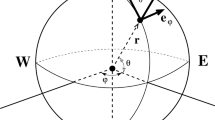Abstract
In his classic work Hydrodynamics, Horace Lamb devoted a significant amount of effort to the mathematical analysis of atmospheric waves, i.e. waves in a compressible medium under the influence of a local gravitational field and a variable temperature (and hence sound speed) profile. In so doing, he derived equations for both the divergence and the curl of the velocity field, yielding expressions of considerable mathematical beauty and complexity. Eight decades later, Derek Moore and Edward Spiegel extended Lamb’s analysis to include an arbitrary external applied force in the equations of motion. By a suitable choice of such force, the governing wave equations for a wide variety of Lorenz force/Coriolis force-induced wave motions can be derived. However, they chose to investigate the radiation field resulting from the application of a concentrated vertical force. In so doing, they were able to utilize an important theorem by James Lighthill concerning the asymptotic radiation field from a source with compact support, using the concept of a wavenumber surface. This paper has two main components: the first is to extend the work of Moore and Spiegel to ion-damped acoustic-gravity waves in the ionospheric F-region, based on the seminal work of C. H. Liu and K. C. Yeh. The second part is a consequence of the first: the corresponding wavenumber surface becomes complex, and so Lighthill’s method has to be modified to account for the effects of this. Furthermore, a significant inconsistency in the formulation of the physical problem by Liu and Yeh has been corrected and the corresponding derivations have been reformulated. Some graphical information has also been provided in special cases to illustrate the comparative effects of damping on the asymptotic behaviour of the acoustic-gravity radiation field. A final feature of the paper is that the equations derived are very general and can provide the basis for investigation of more realistic atmospheric temperature profiles in future work.




Similar content being viewed by others
References
Lighthill, M.J.: Studies on magneto-hydrodynamic waves and other anisotropic wave motions. Philos. Trans. 252A, 397–430 (1960)
Lamb, H.: Hydrodynamics, (Sections 311/2), 6th edn. Dover Publications, New York (1945)
Moore, D.W., Spiegel, E.A.: The generation and propagation of waves in a compressible atmosphere. Astrophys. J. 139, 48–71 (1964)
Adam, J.A.: Rays, Waves and Scattering Topics in Classical Mathematical Physics. Princeton Series in Applied Mathematics. Princeton University Press, Princeton, NJ (2017)
Lighthill, M.J.: Asymptotic behavior of anisotropic wave systems stimulated by oscillating sources. In: Martin, P.A., Wickham, G.R. (eds.) Chapter 1 in Wave Asymptotics. Cambridge University Press, Cambridge (1992)
Lighthill, M.J.: Emendations to a proof in the general three-dimensional theory of oscillating sources of waves. Proc. R. Soc. Lond. A 427, 31–42 (1990)
Hines, C.O., Hooke, W.H.: Discussion of ionization effects on the propagation of acoustic-gravity waves in the ionosphere. Geophys. Monogr. Ser. 18, 445–450 (1970)
Liu, C.H., Yeh, K.C.: Effect of ion drag on propagation of acoustic-gravity waves in the atmospheric F region. J. Geophys. Res. (Space Phys.) 74(9), 2248–2255 (1969)
Yeh, K.C., Liu, C.H.: Theory of Ionospheric Waves. International Geophysics Series, vol. 17. Academic Press, New York (1972)
Kaladze, T.D., Pokhotelov, O.A., Shah, H.A., Khan, M.I., Stenflo, L.: Acoustic-gravity waves in the Earth’s ionosphere. J. Atmos. Soalr-Terr. Phys. 70, 1607–1616 (2008)
Gray, A.: Modern Differential Geometry of Curves and Surfaces with Mathematica, 2nd edn. CRC Press, Boca Raton, FL (1997)
Author information
Authors and Affiliations
Corresponding author
Additional information
Publisher's Note
Springer Nature remains neutral with regard to jurisdictional claims in published maps and institutional affiliations.
Appendix: The complex refractive index and surfaces
Appendix: The complex refractive index and surfaces
In [8] the (complex) refractive index n is defined by
and in the case of axial symmetry here (vertical magnetic field) its square is given by
Recall that in the notation of this paper \(\phi \) is the polar angle of the \({\mathbf {k}}\)-vector (but denoted by \(\theta \) in [8]). Since in the N / D shorthand \(n^{2}\) may be rearranged as
We focus attention on the real part of this expression and eliminate the angle \(\phi \) in terms of the components of the (now real) wavevector \({\mathbf {k}}\), using \(k_{h}=\left| {\mathbf {k}}\right| \sin \phi \), etc. After considerable algebraic rearrangement, the following result is obtained:
The imaginary part of \(n^{2}\) yields the same left-hand side as the real part, namely
Note that the second factor on the left-hand side of both equations is identical to Eq. (6.2) when \(\nu =0.\) Since therefore these latter equations contain an additional factor even for \(\nu =0\) the presence of spurious solutions is possible, and this approach is pursued no further.
Rights and permissions
About this article
Cite this article
Adam, J.A. The asymptotic solution of the ion-damped acoustic-gravity wave equation. Z. Angew. Math. Phys. 70, 118 (2019). https://doi.org/10.1007/s00033-019-1163-6
Received:
Revised:
Published:
DOI: https://doi.org/10.1007/s00033-019-1163-6



